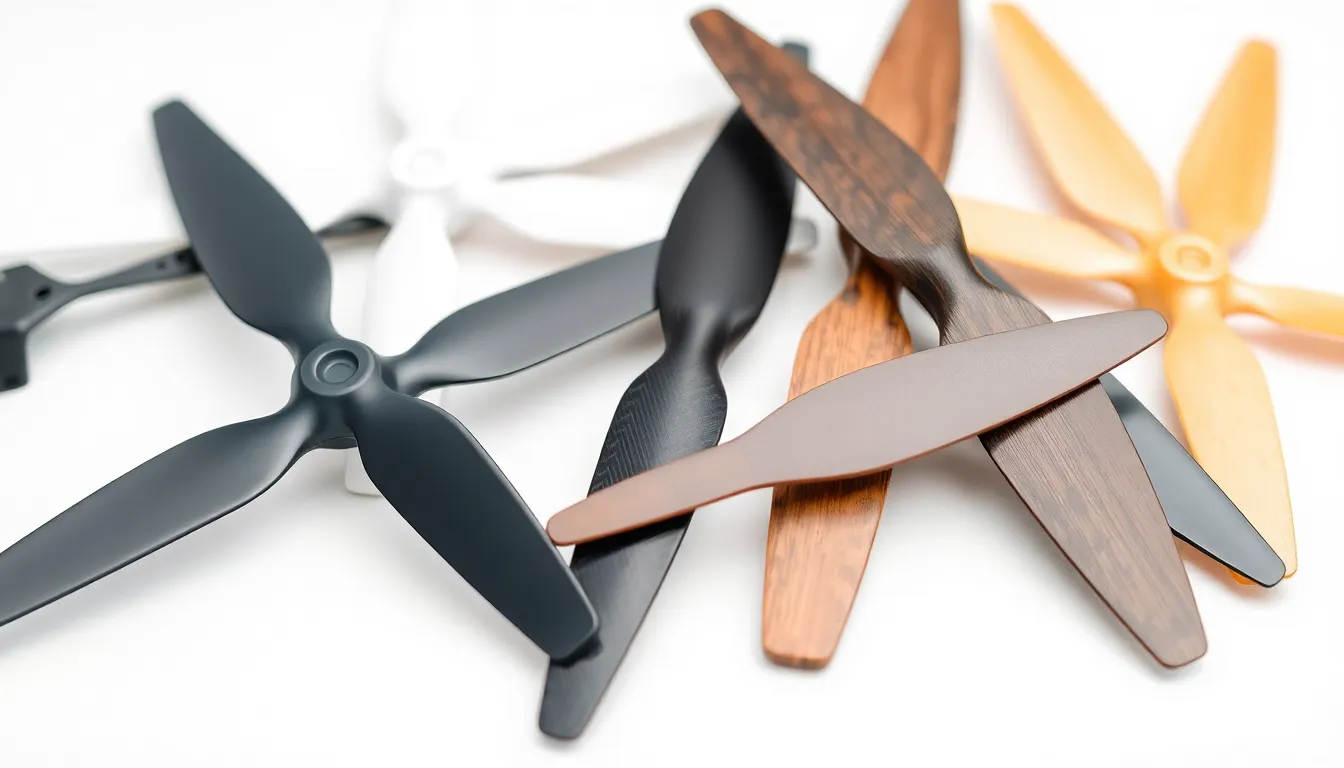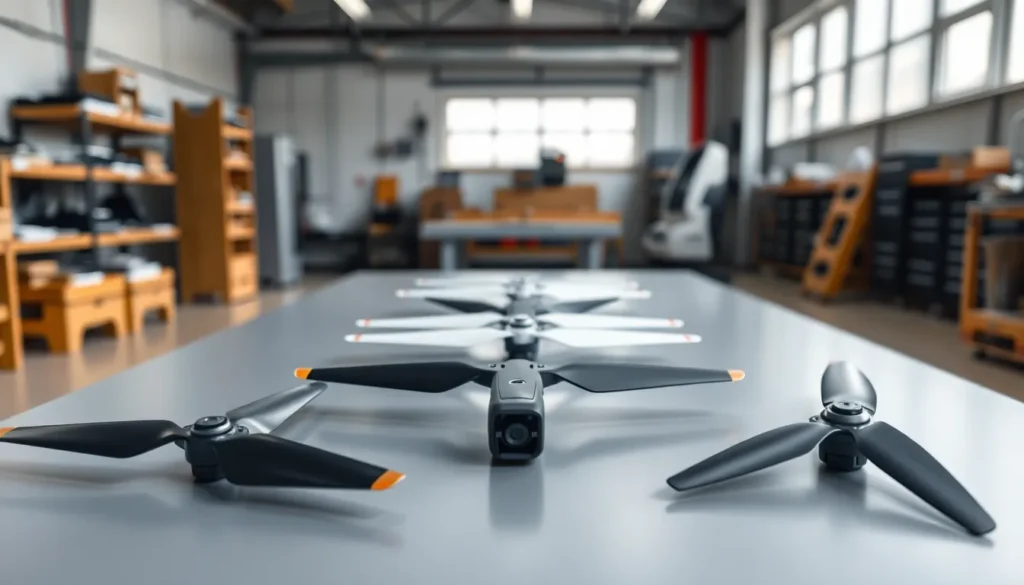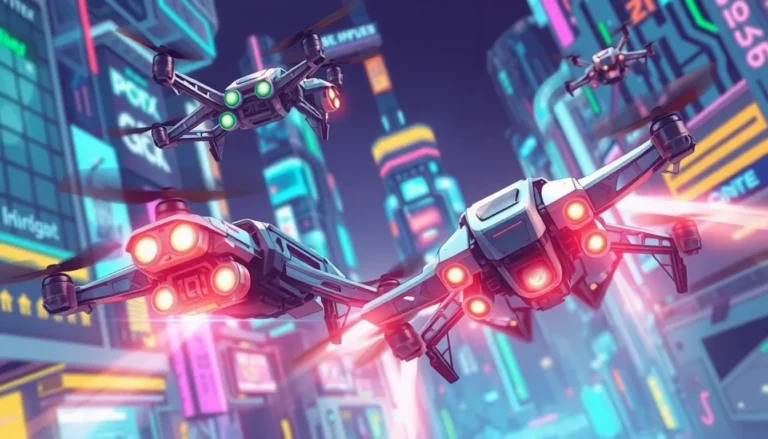Table of Contents
ToggleIn the world of drones, propellers are the unsung heroes, spinning their way to glory while the rest of the craft takes the spotlight. They might look like simple blades, but their design can make or break a flight. Think of them as the stylish shoes of the drone world—without the right pair, you might just trip over your own feet.
Overview of Drone Propeller Designs
Drone propeller designs significantly influence flight performance and maneuverability. Different types of designs cater to specific applications, ensuring optimal efficiency and control. A common propeller type features a two-blade design, which offers a balance of speed and simplicity. In contrast, three-blade propellers enhance thrust and stability, making them ideal for racing drones.
Materials for propeller construction vary, with options like plastic, carbon fiber, and wood, each offering distinct advantages. Plastic propellers are lightweight and economical, while carbon fiber options provide durability and performance at higher speeds. Wooden propellers, though less common, deliver aesthetic appeal and specific acoustic properties.
Blade shape and pitch serve as critical components in propeller design. A wider blade typically generates more lift but can increase drag. The pitch, or angle of the blades, affects acceleration and top speed. Higher pitch values often result in faster flight but compromise thrust at lower speeds.
Propeller size also plays a key role in drone capability. Larger diameters can improve lift, yet they may increase weight and drag. Conversely, smaller propellers tend to enhance responsiveness but might limit overall lift capacity. Engineers adjust these parameters based on drone design objectives and flight requirements.
The efficiency of propeller designs directly impacts battery life and flight duration. Well-designed propellers reduce the overall power consumption, allowing drones to fly longer distances. Precision in design and materials thus yields better performance and adherence to specific mission profiles.
Key Factors in Propeller Design

Several factors influence the performance of drone propellers, ensuring optimal flight characteristics.
Material Considerations
Material selection significantly impacts propeller durability and overall performance. Plastic is lightweight and cost-effective, making it a popular choice for beginners. Carbon fiber offers superior strength and rigidity, which enhances efficiency and reduces vibrations. Wood provides an aesthetic appeal and is often chosen by hobbyists for custom builds. Each material has unique benefits, allowing designers to tailor propeller performance based on specific applications and flight conditions.
Blade Shape and Size
Blade shape and size affect lift, drag, and responsiveness. Wider blades generate more lift but may increase drag, impacting acceleration. Conversely, narrower blades improve efficiency, resulting in faster speeds suitable for racing. Propeller length also plays a vital role; longer propellers enhance lift while offering stability, whereas shorter propellers improve maneuverability. Designers must carefully balance these characteristics to achieve desired flight behavior and efficiency.
Types of Drone Propeller Designs
Drone propeller designs significantly impact performance and efficiency. Different types serve specific applications, providing tailored solutions for diverse needs.
Fixed Pitch Propellers
Fixed pitch propellers have a set blade angle. This design simplifies construction and maintenance, making it popular among hobbyists. Typically, these propellers work well for aerial photography and recreational flying due to their stability and ease of use. They offer reliable performance across various flight conditions, allowing drones to achieve satisfactory lift with minimal adjustments. However, fixed pitch propellers lack the versatility found in adjustable options, as they can’t optimize efficiency in changing flight situations.
Variable Pitch Propellers
Variable pitch propellers allow adjustments to the blade angle during flight. This flexibility provides significant advantages for performance, including enhanced lift and reduced drag. Drones equipped with variable pitch designs can adapt to changing conditions, optimizing power consumption for longer flight times. Additionally, these propellers cater to varied applications, from racing to complex aerial maneuvers, resulting in improved responsiveness. Their sophisticated mechanism requires more maintenance and complexity, but the performance benefits often outweigh these challenges.
Performance Evaluation of Propeller Designs
Evaluating drone propeller designs encompasses multiple factors, including efficiency, noise, and vibration levels.
Efficiency Metrics
Efficiency metrics play a pivotal role in assessing propeller performance. Thrust-to-power ratio indicates how much thrust a propeller generates per unit of power consumed. Designers often prioritize high thrust-to-power ratios for improved battery life and longer flight times. Comparative studies reveal that three-blade propellers typically deliver better efficiency in racing drones due to enhanced lift and stability, while two-blade options excel in speed. Propeller pitch also influences efficiency; a higher pitch creates more lift but can lead to increased drag. Thus, variations in pitch affect overall efficiency, demanding careful consideration during propeller selection.
Noise and Vibration Analysis
Noise and vibration analysis significantly influences drone operation. Propeller designs impact both acoustic noise and mechanical vibrations during flight. Wider blades may produce more noise due to increased airflow disruption, while narrower blades contribute to quieter operation. Additionally, unbalanced propellers generate excessive vibrations, leading to potential structural damage or control issues. Optimizing blade shape and symmetry minimizes these adverse effects. Research indicates that implementing specific design changes can reduce noise levels significantly, enhancing user experience and compliance with regulations in noise-sensitive environments. Consequently, assessing noise and vibration aspects remains crucial in propeller design evaluation.
Innovations in Drone Propeller Technology
Advancements in drone propeller technology continue to reshape the drone industry. Recent innovations include the development of adaptive propellers that optimize performance in real-time. These propellers automatically adjust their pitch based on flight conditions, enhancing efficiency and maneuverability.
Aerospace engineers now focus on biomimicry in propeller design. By studying nature, they create blades that mimic bird wings, improving lift and reducing drag. This approach results in quieter, more efficient propellers capable of extended flight times.
Materials technology also plays a significant role in propeller innovation. Recent trends showcase the use of advanced composites, which combine the best properties of carbon fiber and polymers. These materials offer lightweight, high-strength alternatives that withstand harsh conditions while maintaining flexibility.
The integration of smart technology into propeller design represents another notable shift. Propellers with embedded sensors provide real-time data on performance metrics, allowing for precise adjustments during flight. These sensors enhance safety and performance monitoring, leading to better operational outcomes.
3D printing now revolutionizes manufacturing capabilities in the drone industry. Custom propeller designs can be produced quickly, enabling rapid prototyping and testing. This technology allows enthusiasts and professionals to tailor propellers to specific performance requirements easily.
Research into noise reduction features also gains traction in propeller technology. Innovations focus on blade design that minimizes turbulence, resulting in quieter flight operations. Lower noise levels contribute to urban acceptance of drones, making them suitable for various applications, including delivery services.
Emerging trends illustrate that drone propeller technology is dynamic and continuously evolving. By leveraging new materials, designs, and technologies, developers create propellers that significantly enhance overall drone performance.
The evolution of drone propeller designs showcases the intricate balance between efficiency and performance. As technology advances engineers are continually pushing the boundaries to create propellers that not only enhance flight capabilities but also address noise and vibration challenges. The shift towards adaptive and biomimetic designs reflects a growing understanding of aerodynamics and material science.
With innovations like 3D printing and smart technology integration the future of drone propellers looks promising. These developments will likely lead to more efficient and versatile drones capable of meeting diverse operational needs. As the industry continues to evolve staying informed about these advancements will be essential for enthusiasts and professionals alike.







